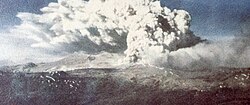Great Chilean Earthquake
The Great Chilean Earthquake or Valdivian Earthquake was the most powerful earthquake ever recorded. The quake occurred in the early evening (19:11 UTC) of May 22, 1960, and had a 9.5 rating[1] on the Moment magnitude scale. The earthquake affected southern Chile, Hawaii, Japan, the Philippines, and the Aleutian Islands in Alaska.
Its epicenter was Valdivia, Chile. The earthquake caused tsunamis that pounded the Chilean coastline with waves of up to 25 meters. The main tsunami traveled across the Pacific Ocean and caused great damage to Hilo, Hawaii. Waves as high as 10.7 meters (about 35 feet) were recorded 10,000 kilometers from where the earthquake started. These waves travelled as far as Japan and the Philippines.
The total number of deaths from the earthquake and subsequent tsunami in Chile has been estimated at 490 to 5700.[2] The Chilean government estimated 2 million people were left homeless and the damage was $550 million USD.[2]
Great Chilean Earthquake Media
Travel time of the tsunami across the Pacific Ocean at one-hour intervals
Hilo, Hawaii, after the tsunami
Effect of the tsunami at Kamaishi, Japan
Eruption of Cordón Caulle following the earthquake
The destroyed center of Corral, Chile
Destroyed infrastructure of Altos Hornos y Acerías de Corral, a steel factory closed a few years before the earthquake.
References
- ↑ "M 9.5 - 1960 Great Chilean Earthquake (Valdivia Earthquake)". U.S. Geological Survey. U.S. Department of the Interior. November 7, 2016. Retrieved July 6, 2019.
- ↑ 2.0 2.1 "May 22, 1960 Southern Chile Earthquake and Tsunami" (PDF). National Oceanic and Atmospheric Administration. U.S. Department of Commerce. March 2015. Retrieved July 6, 2019.









